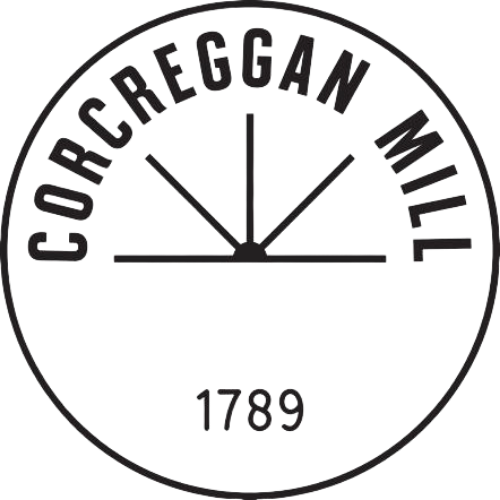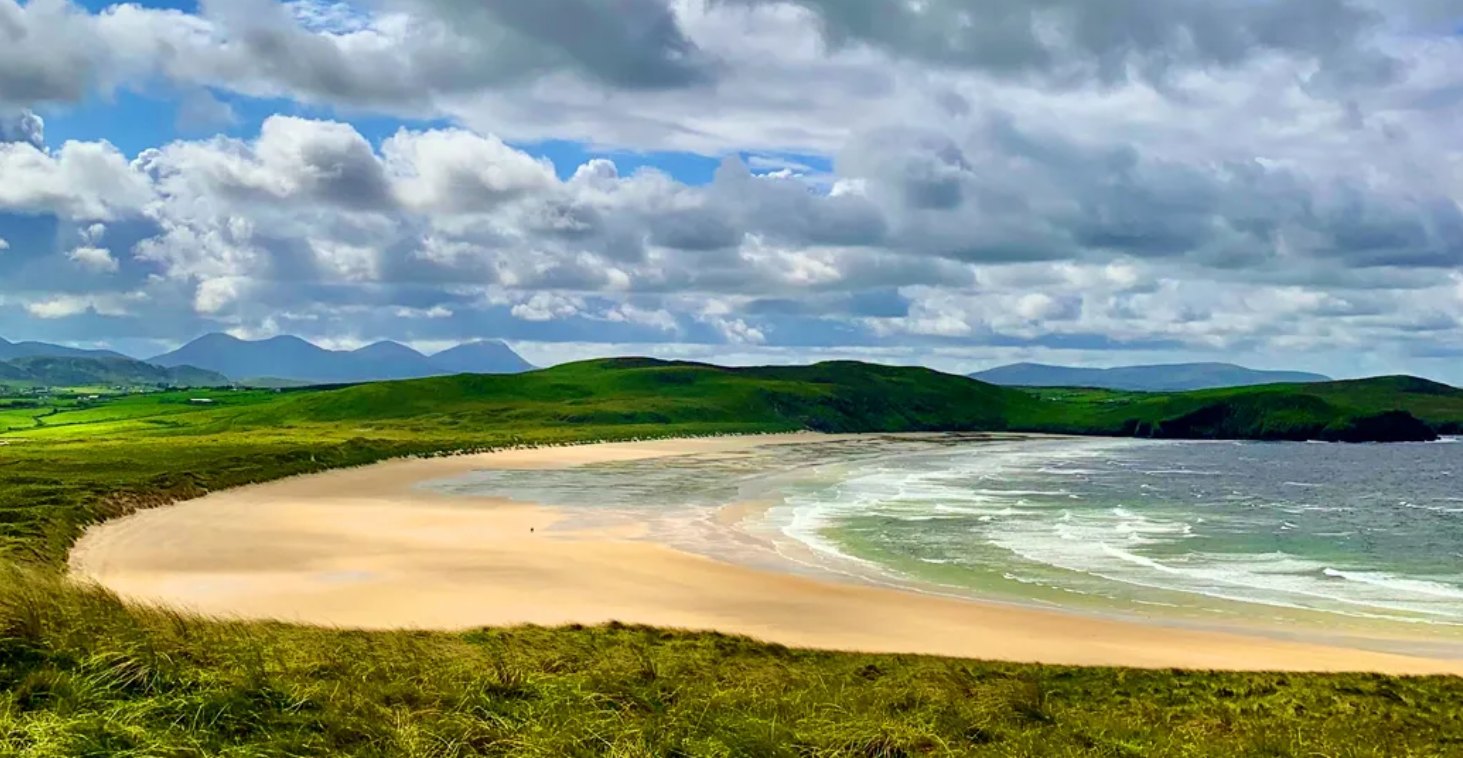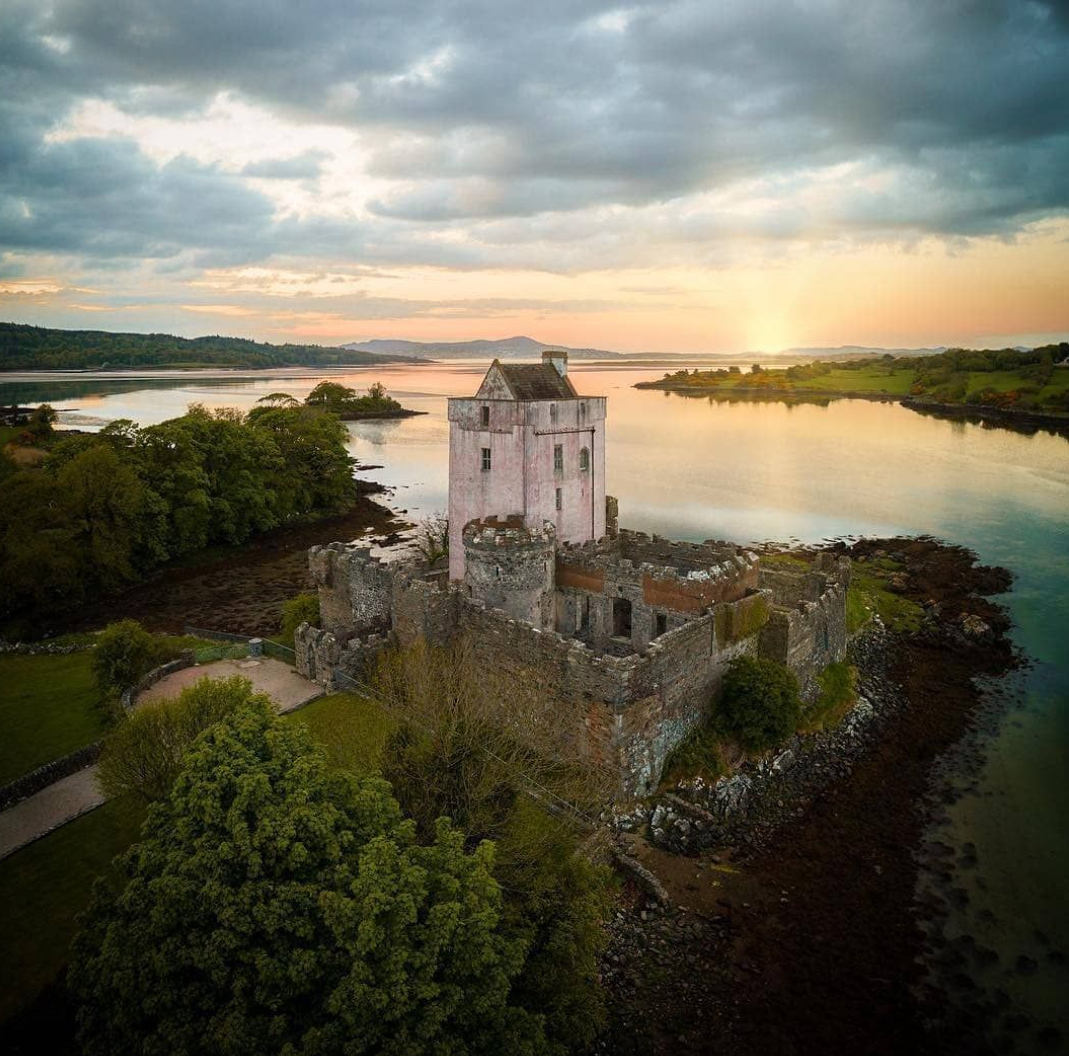Beaches & Sights
Relax and enjoy the peace and tranquillity of the Corcreggan Mill property. Chill out by the Mill stream. Find "The Place of Transformation, one of the 10 power points of the old, pre-Celtic site” and experience the healing stillness as so many others do (meditating, writing, playing music, composing, or just being still). Seek out the other pilgrims and travellers.
Archway leading to the Mill Stream
Join us of an evening, at the western wall to view the setting sun as it reddens the sky over New Lake, Tory Island and the Atlantic.
Nearby
There is a wide variety of spectacular scenery nearby or within easy reach. Just across the road is New Lake, a protected wildlife sanctuary and unique eco-system (formed by a natural disaster in 1917). If you want a peaceful, country-lane walk, there is none better than the road behind (south of) Corcreggan, rather than the sometimes-busy N.56. This quiet country road is also a better option for getting to Dunfanaghy on foot or by bike.
Trá Mór Beach
To the west of New Lake is the remote and magical Trá Mór beach which recently made Lonely Planet’s list of 10 best beaches in Ireland. 2 miles of golden sand with no roads or houses, and very few people, just the continuous foam and spray of the Atlantic rollers. This breath-taking beach is only accessible on foot (20-30 min walk), by way of a grassy, public footpath from Horn Head Bridge.
Marfagh blow-hole blowing
Overlooking the northern end of the beach is a Celtic (or, more likely, a pre-Celtic) stone circle, and, beyond that are Sea-arches and Blow-holes (the largest and most spectacular is known as McSwynes Gun). Sadly, the Loop Walk, including the Stone Circle and McSwynes Gun is no longer open to the public.
The greater part of the 650ft (200m) Horn Head Sea Cliffs can be seen from the road if you choose to take the easy option, by following the narrow, clockwise (for the best views) road route around Horn Head. These will be officially accessible from 2013 via a new Coastal Loop Walk.
Killyhoey beach is easily accessed, either on foot from the green in front of Arnold's Hotel, or by foot, bike or car, through the Golf Links to the car park at the middle of the beach.
Killyhoey beach and Portnablagh from Horn Head
Killyhoey (church of the graves) is over 2km long and is the most popular locally because of the easy access, Blue Flag grading and safe swimming. As a consequence it can get very crowded in summer, attracting as many as forty people at a time!
The headland to the east of Killyhoey is Breaghy Head, frequented in the early part of the 20th century by many national and international notables such as W.B. Yeats, George Russell (AE), Captain Scott, P.H. Pearse, Percy French, etc. The beach on the northeast side of Breaghy is called Marble Hill, where AE described meeting Pan, the God of the Nature Kingdom. It was to this area that AE brought WB Yeats and it may well have been here that Yeats was introduced to ‘the otherworld’, from which stems our mythology, and upon which they both drew for their inspirational stories, poems and paintings of the faery realm.
Lady Isabella's Tunnel
The next headland, east of Breaghy, is known as Ards, where Ards Forest Park is located and which has another very nice beach, an old, artificial lake and a maze of wonderfully scenic nature trails. It is accessible by car via the main entrance (which has a toll gate, so don't forget to have €5 in coins for exiting). The park can also be accessed on foot, through Lady Isabella's Tunnel, just opposite Ballymore Church and School. There is a car-park, children's playground and lovely beach at the end of the road.
Doe Castle
Yet further east, past Ards Forest Park, follow signposts to Ards Friary. This is where the magnificent Ards House once stood, the grand manor house of the Stewart family, of whom Lady Isabella, Dingaval, Tasca, Stewart-Bam is best remembered locally. It was demolished to make way for the new Friary in 1966. Beside the Friary there is a coffee shop, a lovely walk, under the big trees, alongside the estuary, to Isabella's Bay, and a trail across the headland to Lucky Shell beach. From there, there is another trail, through the forest, leading back to the Friary again (see Walk 8 in the Walk Guide).
On the distant shore is the Mc Sweeney stronghold known as Doe Castle. It was from here that the English captured the teenager, Red Hugh O'Donnell, The Prince of Tír Connaill (Donegal), who would later, with his neighbour, Hugh O'Neill, Prince of Tír Eoghan (Tyrone) take part in the ill-fated Battle of Kinsale in 1601.
Within easy reach
Inis Bo Finne
Many guests make day-trips to Glenveagh National Park, Dunlewy Lakeside Centre, Muckish and Errigal Mountains (don’t forget to ask me about the Bridge of Tears) and there are ferries to take you to the famous Tory Island, homeland of the pirates of old, and more recently, a world-renowned primitive art school. Closer to shore, but completely un-commercialised, is the quaint and peaceful Inis Bo Finne. This island has one of the best beaches in the whole region (actually, in the whole world, to my mind), and the very best drinking water to be had anywhere. (Ferry Service, Phone Michael, 0876279789).
Mountain from Ballymore Church. The white stain down the centre of the mountain shows where the old Silica mine and workings used to operate.
Things to do in the area The wonderful scenery is made more accessible and enjoyable because of the wide variety of activities which one can participate in or attend in the immediate locality.
The Bridge of Tears
Within a 15-mile (25km) radius you will find:
An Ghaeltacht (Irish speaking regions) & Gaeltacht Summer Colleges
Doe Castle
Muchish and Errigal Mountains
The Bridge of Tears
Glenveigh National Park (Castle and Gardens)
Dunlewy Lakeside Centre
Tory Island
Inis Bo Finne (Inisbofin Island)
Milford Clay Pigeon Range
Sheephaven Diving Centre
Grianán of Aileach
A little further afield, the stone fort of Grianán of Aileach has sat on the Inishowen Peninsula since 1700 BC, and in its lifetime it has gained quite a few interesting stories. The fort is linked with the mythical Tuatha Dé Danann and their god Dagda, and later with the baptism by St Patrick of local chieftain Eoghan, from whom Inishowen gets its name! And the tales of this spot may not be over – legend goes that the giants of Inishowen are lying sleeping under Grianán of Aileach, but once a hidden sacred sword is removed they will spring back to life to reclaim their ancient land. So stay on your toes!
From the site there are spectacular views over Lough Foyle, Lough Swilly and the surrounding countryside. The stone fort is believed to have been constructed during the 8th or 9th century as the seat of Cenél nEógain, rulers of the ancient kingdom of Aileach. The interior of the circular fort measures some 23m across and an entrance passage extends through the thickness of the massive encircling wall. This dry-stone wall stands some 5m high and incorporates a series of terraces that are accessed by stone steps.
The monument clearly has ancient origins and surrounding the stone fort are the remains of a much older hillfort that was most likely constructed around 1000BC. There is also a small stone cairn nearby that is most likely a burial monument from the Neolithic or Early Bronze Age.

![[Group 1]-P1140331_P1140343-13 images.jpg](https://images.squarespace-cdn.com/content/v1/564a3d05e4b069dff35f61ee/1449003985779-9MOVHO4TRQPIDEJJ8RMY/%5BGroup+1%5D-P1140331_P1140343-13+images.jpg)








